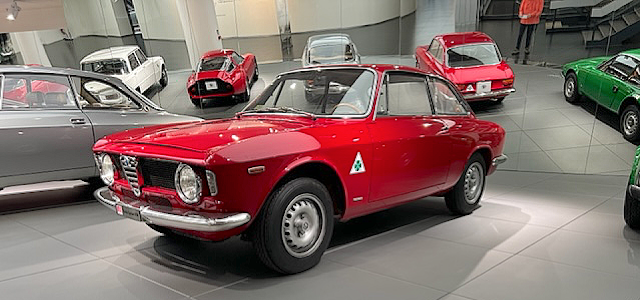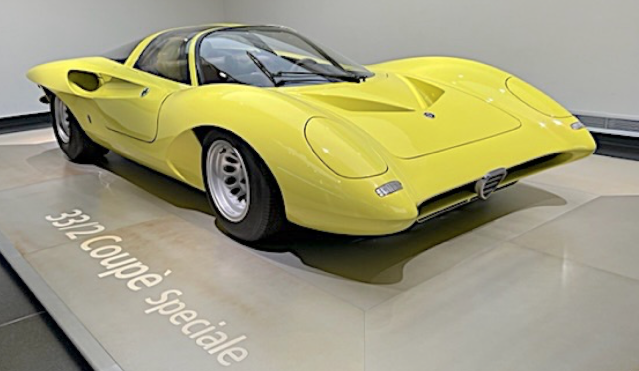Because eras pay no attention to the calendar, it should not come as a big surprise that our survey of legendary Alfas from the Fifties and Sixties begins with a car based on a 1938 design. This was the Type 159, a refinement of Gioachinno Colombo's design for the Alfetta 158 which aimed at voiturette racing, which related to Thirties GP racing as Formula 2 related to Formula 1 in the post-WW2 period. For the prewar 1.5 liter formula, Colombo created a 1.5 liter straight eight with Alfa's by-then expected twin overhead cams, and a single-stage Roots supercharger. Rear suspension was, as on the 8C 2900, by swing axles. The car developed around 200 hp and assumed more significance when GP regulations were changed to favor smaller engines for the 1940 season, but war stopped racing, along with much of everything else, in its tracks...
After the war, though, Alfa management realized they had a car well-suited to the new Grand Prix formula, which limited supercharged engines to 1.5 liters and normally aspirated ones to 4.5. Alfa engineers tweaked the engine to produce around 50% more power than the pre-war version, in the Tipo 158 / 47. Driver Achille Varzi was tragically killed in this car's debut in the Swiss GP of 1948, but Giuseppe Farina won the 1950 World Driver's Championship in this version of the 158. For 1951, Alfa came back with the 159, which featured 2-stage supercharging, an amazing 420 hp, and a new De Dion rear axle. With the 159, Juan Manuel Fangio won the first of his 5 World Championships that year. In the same era, Alfa produced the AR-51 "Matta" four-wheel drive vehicle for the Italian military. Not surprisingly, the AR-51 brought Alfa's new four-cylinder twin-cam 1900 engine into a different field of service...
The next year, in 1952, Carlo Anderloni's Touring Superleggera produced advanced alloy body work on chassis powered by a 2 liter four based on the 1900, but enlarged and with an aluminum block, as well as a new 3.5 liter twincam inline six based on the 3000 CM race car. The Disco Volantes* ("flying saucers") reflected the postwar fascination with outer space, and featured ovoid, lenticular sections, front to rear and side to side. Though only 5 cars were produced, their wind-tunnel tested forms can be found (especially if you squint) in designs as diverse as the D-Type Jaguar and the Corvette Stingray, which adopted doors curving into the roof (a feature of the lone Disco coupe) as well as the strong horizontal line separating the upper fender forms from the lower body.
The convex spears formed into the deck became conventional headrest supports on the one Disco Volante that was actually raced, the "narrow-hipped" 2 liter spyder, so called because it lacked the bulging sides of the other cars. That car is directly below the C52 below for comparison...
A similar narrow body was produced by Colli for six cylinder 3000CM race cars that competed in the Mille Miglia. Fangio took 2nd place in 1953 in one of those coupes...
A mysterious V12 engine on display is also dated from 1952, but GP races in that year were run to Formula 2 specifications. Was this a new GP engine for the earlier formula (4.5 liters normally aspirated, 1.5 liters supercharged) that was ready too late? If so, it's ironic because Alfa's withdrawal from GP racing after their 1951 Chanpionship prompted the change to Formula 2 rules…
At the same time, over at Bertone, designer Franco Scaglione* was designing up a storm of innovation, including the famous BAT* coupes, none of which are at the Museo Storico. What is there, however, is one of two prototype 2000 Sportiva coupes, based on the same 2 liter engine as the first Disco Volantes. In 1954 the designer experimented with ideas that would appear on two of Bertone's production cars for Alfa, the mass-produced Giulietta Sprint and the more limited Sprint Speciale.
Those ideas included the fastback roof line with parabolic arc reflected in the section and plan of the rear window (both cars), the shape of the tail lights (Sprint coupe), and the placement of the Alfa shield grille shape as a decorative element in the center of a low, oval air intake (Sprint Speciale).
The 1300 Giulietta sedan shown below appeared after the 1954 Giulietta Sprint coupe. Bodywork on the sedan was designed and built at Alfa's Milan factory, and reflects the company's more conservative approach to sedans.
Bertone's Sprint Speciale, shown below, first appeared in 1957. Early prototypes had an even lower nose than the example car. Like the Giulietta series itself, the Sprint Speciale enjoyed a long life, starting production in 1959 and extending into the Giulia series in 1966.
The Sprint Speciale was the first production Alfa to have a subtly chopped tail with a recessed panel beneath the deck (barely visible in mirror above and below). Zagato's Coda Tronca, shown below, had a much more pronounced chop, also shown in the mirror, and fewer than 50 were produced in 1961-62..
Also in 1962, Alfa introduced its new Giulia 105 series, first with the square-rigged sedan shown below. Possibly as a result of the dropped nose and the concave indent along the fender tops, the car has a lower CD than expected, and became a successful sedan racer.
Giorgetto Giugiaro's design for Bertone's new 2000 Sprint coupe went into production in 1961 and lasted into 1962, when after only 740 examples it became the 2600 coupe with new aluminum block six. This version lasted into 1968; more importantly, the roof shape would be echoed in the 1963 Giulia GTV, a design that would stay in production a dozen years.
The silver 1965 prototype for the Giulia version of the Bertone's Giulietta Sprint Speciale was designed by Giugiaro, and shows some influence from his earlier Corvair Testudo show car, including the large, wraparound rear window with reverse slant B-pillar, and the horizontal crease along the flanks. The production Giulia versions of the Sprint Speciale, however, used the old design.
Giugiaro's GTV design for Bertone had great popularity with the public from the start, and the body design was also built in alloy for the GTA factory road racers, as shown below.
Zagato followed the Coda Tronca with the tubular chassis, independent rear suspension, alloy-bodied TZ, and built over a hundred. For the TZ2 in 1965, engineer Carlo Chiti's Autodelta team adopted magnesium castings, twin-plug ignition, dry sump lubrication, and a body built in fiberglass, a first for Zagato. Power went up to 170 and top speed to 160, but costs were higher as well, so production amounted to a dozen.
One figure that did not increase was overall height, the roof of the TZ2 was only 41 inches above the road, requiring a new design for the seats, with a more reclined driving position.
One of the other projects occupying ex-ATS engineer Carlo Chiti at the Autodelta racing operation was the Type 33, a mid-engined 2 liter road racer with a 2 liter V8 engine. This was not a surprising configuration when you consider that his design for the short-lived ATS* road car had been a 2.5 liter V8 in the same location. But in the Type 33, he specified twin-cam heads, where the ATS had been an SOHC design. The new engine produced 240 hp, making the Stradale road version below an early Supercar. Even without the landmark engine, the Stradale would've been noted for the body design by Franco Scaglione, who had left Bertone. Touring needed the body contract, but the company expired in 1966. First prototypes were built by Scaglione's crew, and later cars by Carrozzeria Marazzi, a firm composed of ex-Touring artisans who also built the Lamborghini Islero. At a time when a Stradale's price would've bought a Lamborghini Miura, demand was limited. Only 18 chassis were produced from late 1967 to spring 1969, and 12 received the Scaglione body design...
This begs the question of what happened to the other chassis. They went to coachbuilders like Bertone, Giugiaro's new Ital Design, and Pininfarina and became spectacular show cars. In 1968, Ital Design showed the Iguana below. It continued the exploration of creased wedge forms he'd started with the DeTomaso Mangusta and the Maserati Ghibli, and also confirmed his preference for silver as the color for show cars. Here, though, the silver tone was achieved by polishing the alloy body to a medium reflectivity...
At Bertone, designer Marcello Gandini produced the most memorable Type 33 prototype, the Carabo, also in 1968. It took the wedge trend to a new extreme, emphasizing the low chassis with dropped window sills and dark body sills, and a startling color scheme including special bronze glass. It also featured the scissor doors that later showed up on Gandini's design for the Lamborghini Countach...
At Pininfarina, Leonardo Fioravanti's design for the 33/2 Coupé Speciale went off in the opposite direction. Composed of a series of compound-curved volumes and voids, the Speciale almost seemed a protest against the wedge fashion. It was closely related to the Ferrari P5 show car Fioravanti had designed for PF the previous year, and some suggested that the P5's body had simply been grafted onto the Type 33 chassis.
The 33/2 Coupé Speciale, like the Carabo and Iguana, would remain a unique example of an idea Alfa chose not to produce in quantity. Even the Stradale bodies designed by Scaglione were so few, and different in detail from car to car, that "production" doesn't apply. When Alfa Romeo finally decided to offer a production car related to their V8 racing engine, it would turn out to be a front-engined relative of the successful Giulia series. That story will be told in Part 3...

*Footnote:
We surveyed Franco Scaglione's work on Alfa and other chassis in "Unsung Genius Franco Scaglione: The Arc of Success" (Dec. 20, 2017) and in "Bertone's Bookends: Alfa Romeo BATs" (Aug. 25, 2020). Touring Superleggera body designs on Alfa chassis were featured in "Touring Superleggera: The Italian Line Travels Light" (Sept. 30, 2020) and the influence of their Disco Volante on other Alfas in "After the Flying Saucers", posted Aug. 5, 2018. The history of Zagato-bodied Alfas was summarized in a photo essay entitled "Body by Zagato Part 2: Five Decades of Alfa Romeos", posted May 6, 2020. And we reviewed the saga of the ATS make, and attempts ot revive it, in "Forgotten Classic Revival Show" (Nov. 12, 2018).
Photo Credits:
All photos were generously provided by George Havelka.























No comments:
Post a Comment